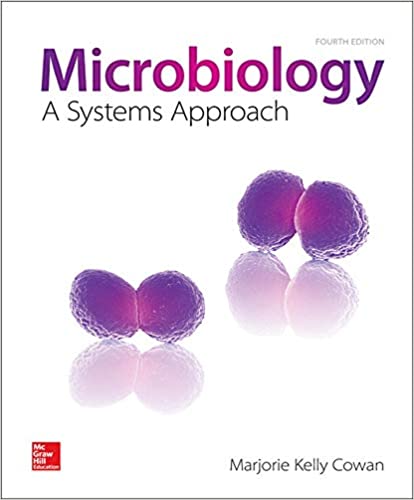
Microbiology: A Systems Approach 4th Edition by Marjorie Kelly Cowan
Edition 4ISBN: 978-0073402437
Microbiology: A Systems Approach 4th Edition by Marjorie Kelly Cowan
Edition 4ISBN: 978-0073402437 Exercise 5
Where Did All the Methane Go
The British Petroleum (BP) Deepwater Horizon oil spill in the Gulf of Mexico in April 2010 was the largest oil spill in history, releasing an estimated 4.9 million barrels of oil (205.8 million gallons), contaminating 665 miles of coastline, and having an untold impact on the environment. Among the many concerns about the impact that the massive spill would have on the Gulf of Mexico and its flora and fauna, scientists were concerned that the methane released by the spill would eventually make its way into the atmosphere and, as a greenhouse gas, would contribute to global warming. Others speculated that it would remain trapped in the ocean, suffocating all life and creating "dead zones." According to measurements by the Department of Energy (DOE) and BP, methane was proportionately the most abundant substance released in the spill as compared to crude oil and octane.
When researchers studied methane levels in the ocean shortly after the spill, they found a layer 110 to 220 yards thick about two-thirds of a mile below the surface at concentrations 10,000 to 100,000 times the normal levels-the highest concentration of methane ever measured in the ocean. As scientists continued to monitor the methane concentration in the Gulf, they made a surprising finding: The concentration of methane decreased to nearly zero within the space of a few months. What accounted for the dramatic drop in methane levels in the Gulf You guessed it: bacteria.
Where did the methane-consuming bacteria in the Gulf of Mexico come from
What microbial species were involved in the methane consumption
Methane-consuming microbes, also known as methanotrophs , exist naturally in the environment and cluster around methane-seeping vents in the ocean floor, living off of the small amounts of methane released there. However, when the Deepwater Horizon exploded, there was a massive increase in methane in the area-a banquet for methanogens. For 2 months, they gorged themselves on the abundance of methane and consumed nearly all of the methane released in the spill. Scientists estimate that these microbes consumed 200,000 tons of oil and natural gas within 5 months after the spill. They utilized metagenomic analysis to determine the identity of the methane consumers and found Oceanospirillales, Colwellia, Methylococcaceae, and Cycloclasticus. All of these organismsare also psychrophilic and grow optimally at 40°F, thetemperature at the depths where the largest concentration ofmethane was found in the Gulf.

How did scientists measure the volume of methane that had been consumed by microbes
The British Petroleum (BP) Deepwater Horizon oil spill in the Gulf of Mexico in April 2010 was the largest oil spill in history, releasing an estimated 4.9 million barrels of oil (205.8 million gallons), contaminating 665 miles of coastline, and having an untold impact on the environment. Among the many concerns about the impact that the massive spill would have on the Gulf of Mexico and its flora and fauna, scientists were concerned that the methane released by the spill would eventually make its way into the atmosphere and, as a greenhouse gas, would contribute to global warming. Others speculated that it would remain trapped in the ocean, suffocating all life and creating "dead zones." According to measurements by the Department of Energy (DOE) and BP, methane was proportionately the most abundant substance released in the spill as compared to crude oil and octane.
When researchers studied methane levels in the ocean shortly after the spill, they found a layer 110 to 220 yards thick about two-thirds of a mile below the surface at concentrations 10,000 to 100,000 times the normal levels-the highest concentration of methane ever measured in the ocean. As scientists continued to monitor the methane concentration in the Gulf, they made a surprising finding: The concentration of methane decreased to nearly zero within the space of a few months. What accounted for the dramatic drop in methane levels in the Gulf You guessed it: bacteria.
Where did the methane-consuming bacteria in the Gulf of Mexico come from
What microbial species were involved in the methane consumption
Methane-consuming microbes, also known as methanotrophs , exist naturally in the environment and cluster around methane-seeping vents in the ocean floor, living off of the small amounts of methane released there. However, when the Deepwater Horizon exploded, there was a massive increase in methane in the area-a banquet for methanogens. For 2 months, they gorged themselves on the abundance of methane and consumed nearly all of the methane released in the spill. Scientists estimate that these microbes consumed 200,000 tons of oil and natural gas within 5 months after the spill. They utilized metagenomic analysis to determine the identity of the methane consumers and found Oceanospirillales, Colwellia, Methylococcaceae, and Cycloclasticus. All of these organismsare also psychrophilic and grow optimally at 40°F, thetemperature at the depths where the largest concentration ofmethane was found in the Gulf.

How did scientists measure the volume of methane that had been consumed by microbes
Explanation
Microbial ecology is the study of the re...
Microbiology: A Systems Approach 4th Edition by Marjorie Kelly Cowan
Why don’t you like this exercise?
Other Minimum 8 character and maximum 255 character
Character 255


